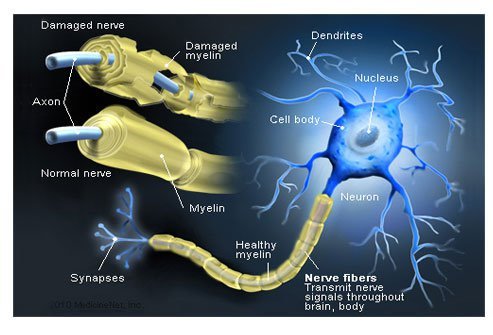What Are the Very First Signs of Multiple Sclerosis?
How do you get multiple sclerosis?

Multiple sclerosis (MS) is an inflammatory, neurodegenerative, and autoimmune disease that affects the brain and spinal cord of the central nervous system (CNS).
Within the CNS, the immune system attacks and damages the fatty substance that surrounds, insulates and protects the nerve cell (myelin sheath). This damage to nerve cells is known as demyelination. This results in the inability of the brain and its electrical impulses to perform normally, causing various nerve-related symptoms of MS. The damaged areas develop multiple areas of scarring of the brain and spinal cord, which gives the disease its name.
MS is one of the most common causes of non-injurious disability in young and middle-aged adults.
The exact cause of the disease is unknown; however, scientists believe that a combination of factors triggers MS, including:
- Genetic factors
- Family history of MS
- Viral infection due to Epstein-Barr virus
- Low levels of vitamin D due to low sunlight exposure
- Age between 15 and 45 years
- A high-risk ethnic group such as Eskimos
- Hepatitis B vaccine
- Women are more affected than men
- Obesity
- Cigarette smoking
What are the very first signs of multiple sclerosis?
The presentation of MS varies from individual to individual. Sensory loss, vision loss, double vision, blurred vision, and pain on eye movement are early signs of MS
Some people have a predominance of changes in thinking, while others develop muscle cramping with spasticity; bladder, bowel, and sexual dysfunction; depression; or visual symptoms.
The prominent feature of MS is what is called an “attack” wherein symptoms occur and then resolve (remit) and may appear again (relapse) sometimes months or years apart affecting different organs. The most common symptoms are:
- Sensory loss
- Fatigue (occurs in nearly 80 percent of patients)
- Walking difficulties
- Numbness of the face, arms, and legs
- Muscle spasms in the leg
- Deterioration of unused muscle leading to muscle weakness
- Dizziness and lightheadedness are commonly seen in patients with MS
- Sexual problems
- Constipation
- Loss of bowel control
- Loss of bladder control
- Chronic pain and itching (noted in 55 percent of patients)
- Memory loss
- Analytical and problem-solving ability starts diminishing
- Significant depression, mood swings, irritability, and other emotional changes
Less common symptoms seen are:
- Slurring speech (dysarthria) and loss of volume (dysphonia)
- Difficulty in swallowing (dysphagia)
- Vigorous shaking (tremor)
- Sudden uncontrollable vigorous jerking (seizures)
- Breathing difficulty
- Hearing loss or impaired hearing
Secondary symptoms that occur as a complication of the above symptoms are:
- Loss of bladder control leads to urinary tract infection
- Physical inactivity or immobility leads to bedsores, muscle weakness, and poor posture
What are the different types of multiple sclerosis?
There are four types of MS, based on the relapse rate and time to disease progression:
- Relapsing-remitting multiple sclerosis (RRMS): A recurrent attack is the characteristic of relapsing-remitting multiple sclerosis RRMS (which resolves completely on treatment). The relapse period may last for weeks to years.
- Secondary progressive MS (SPMS): Secondary progressive MS (SPMS) occurs when patients with RRMS develop a rapid worsening of the disease. It does not respond to the currently available treatment.
- Primary progressive MS (PPMS): Primary progressive MS accounts for approximately 10 percent of patients with MS in which the function diminishes gradually without relapses.
- Progressive-relapsing MS (PRMS): In progressive-relapsing MS (PRMS) bouts of symptoms overlay the progressing disease. It accounts for 5% of the total MS cases.
What tests help in diagnosing multiple sclerosis?
Currently, there are no specific symptoms, physical findings, or laboratory tests that are used to diagnose MS. However, approaches for diagnosing MS include:
- taking a medical history
- a nerve-related examination
- various imaging tests, particularly magnetic resonance imaging (MRI)
- spinal fluid analysis
- blood tests to rule out any underlying conditions
A spinal tap involves the collection of spinal fluid, using a needle and syringe, in order to confirm the presence of any inflammation and other substances.
What is the life expectancy for a person with multiple sclerosis?
MS, if untreated, can lead to physical disability within 20-25 years after onset. The survival rate in MS is correlated with disability. Patients with MS have a high risk of falling; hence care should be taken to prevent falling.
